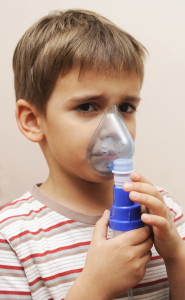Asthma is a chronic lung disease affecting ten percent of school-aged children in the United States. In Philadelphia, this number jumps to almost 25 percent, and in some neighborhoods, nearly 50 percent of school-aged children have been diagnosed. The Pennsylvania Integrated Pest Management (PA IPM) program — a collaboration between the College of Agricultural Sciences at Penn State and the Pennsylvania Department of Agriculture — is partnering with the School District of Philadelphia (SDP) to reduce asthma triggers in schoolchildren by preventing pests, including mice and cockroaches, from entering schools.
“Asthma can limit physical activity, and is the number one reason for school absenteeism Nationwide,” said Michelle Niedermeier, community IPM coordinator for PA IPM. “While asthma cannot be cured, it can be controlled with medication and by avoiding common triggers such as tobacco smoke, mold, cockroaches, and mice. School buildings that can be easily penetrated by mice and other pests might be a contributing factor to this high incidence of asthma.”
According to Niedermeier, an asthma attack can be triggered by a protein found in mouse urine. “Mice are ubiquitous; they pee all the time, so there are urine droplets everywhere they’ve been,” she said. To help alleviate this problem, PA IPM is helping the school district educate staff and students about asthma triggers. They also are assisting with SDP’s rodent reduction campaign via the door sweep initiative, to keep pests out of buildings.
“Cockroaches and mice often come in the same way we do — through the front door,” said Niedermeier. “If there’s a big gap at the bottom of the door, they can just walk in, even though the door is closed.”
Niedermeier and her colleague, Dion Lerman, environmental health programs specialist for PA IPM, assisted with the inspection
of schools’ exterior doors and helped to develop a strategy for selecting the most appropriate and effective door sweeps. Lerman also created a video (https://www.youtube.com/watch?v=eozbRdZbKB8&feature=youtube) to teach district facilities staff members how to properly install the door sweeps. So far, SDP has installed about 1,500 new door sweeps in its buildings.
“This initiative already has been preventing pests from entering schools underneath exterior doors,” said Francine Locke, director of environmental services at the School District of Philadelphia.
As a land-grant university, part of Penn State’s role is to help Pennsylvania’s communities to implement research findings and best practices. “The SDP, like many across the U.S., has pest issues and kids with asthma, and by lending our expertise we can help alleviate some of the risk factors. The door sweeps are a good first step in preventing the pest from becoming a problem,” said Niedermeier.
“The School District of Philadelphia has learned from PA IPM that the pest management chemicals used to address pests in schools may sometimes be more harmful in terms of toxicity, carcinogenicity and respiratory irritants than the pests themselves,” said Locke. “Our IPM program is strategic in terms of how we identify pests in schools, how they are entering a building, the environmental conditions in schools that promote pests and the many different district departments and operations that could affect pests in terms of creating conditions that attract pests. The support and technical guidance of PA IPM has been extremely helpful in guiding our district to healthy and safe ways to prevent and address pests in schools.”
In addition to the partnership that PA IPM has built with the SDP, it also works with the U.S. Environmental Protection Agency, the Pennsylvania Department of Health, the American Lung Association via the Pennsylvania Asthma Partnership, the Children’s Hospital of Philadelphia’s Community Asthma Prevention Program and other organizations and agencies to address asthma-related issues. They aim to carry out the mission of World Asthma Day: to encourage the identification of allergens and irritants that can lead to asthma attacks, and to create asthma action plans for minimizing these irritants as well as other topics, with the goal of improving asthma awareness and care. World Asthma Day is being celebrated this year on May 3rd.
For more information about World Asthma Day, go to http://worldasthmaday.org/. For more information about PAIPM in Philadelphia, go to http://extension.psu.edu/pests/ipm/community



 .
.